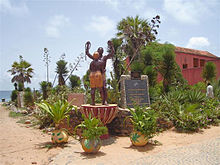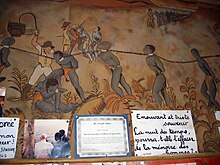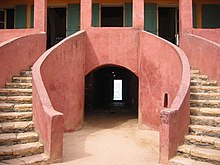154:), who owned several ships and participated in the slave trade. Conditions in the building were harrowing, with many of the imprisoned perishing before they reached the ships. Captured enslaved people "were imprisoned in dark, airless cells", and "spent days shackled to the floor, their backs against the walls, unable to move." Families were separated both at the House, with men, women, and children being held in separate quarters, as well as after boarding the ships, since most of them were not sent to the same locations. Young girls, in particular, were held separately from the rest of the imprisoned, being "paraded in the courtyard so that the traders and enslavers could choose them for sex"; if they became pregnant, they were allowed to remain on the island until they gave birth. Converted into a museum and memorial in 1962.
206:. Researchers argue that while the houseowner may have sold small numbers of enslaved people (kept in the now reconstructed basement cells) and kept a few domestic enslaved people, the actual point of departure was 300m away at a fort on the beach. The house has been restored since the 1970s. Despite the significance of Gorée Island, some historians have made claim that only 26,000 enslaved Africans were recorded as having passed through the island, of the unknown number of slaves that were exported from Africa. Ndiaye and supporters have submitted that there is evidence, the building itself, was originally built to hold a large number of enslaved people, and that as many as 15 million people passed through this particular
35:
143:
214:
115:
127:
166:
225:, argue that enforced transports from Gorée began around 1670 and continued until about 1810, at no time more than 200 to 300 a year in important years and none at all in others. Curtin's 1969 accounting of enforced trade statistics records that between 1711 and 1810 180,000 enslaved Africans were transported from the French posts in
190:
Since the 1980s, academics have downplayed the role that Gorée played in the
Atlantic slave trade, arguing that it is unlikely that many enslaved people actually walked through the door, and that Gorée itself was marginal to the Atlantic slave trade. Ndiaye and other Senegalese have always maintained
253:
in 1807. Other academics have also pointed out that Curtin did not account for the number of individuals who died during transport or shortly after their capture, which could have added significantly to his estimate. In response to these figures, popularly rejected by much of the
Senegalese public,
173:
The House of Slaves was reconstructed and opened as a museum in 1962 largely through the work of
Boubacar Joseph Ndiaye (1922–2009). Ndiaye was an advocate of both the memorial and proclamation that enslaved people were held in the building in great numbers and from here transported directly to the
290:, 200,000 visitors a year pass through the Museum here. Many, especially those descended from enslaved Africans, describe highly emotional reactions to the place, and the pervasive influence of Ndiaye's interpretation of the historical significance of the building: especially the
258:
documented 103,000 slaves being from Gorée on Nantes-owned ships from 1763 to 1775. However, the evidence for this claim was a document that cited 103,000 enslaved
Africans being taken from the larger region of Upper Guinea on the whole, not Gorée specifically.
178:. Eventually becoming curator of the Museum, Ndiaye claimed that more than a million enslaved people passed through the doors of the house. This belief has made the house both a tourist attraction and a site for state visits by world leaders to
393:
241:. Curtin has been quoted as stating that the actual doorway memorialised likely had no historical significance, due to the fact that it was built in the late 1770s and "late in the era to be of much importance", with
294:
through which Ndiaye argued millions of enslaved
Africans left the continent for the last time. Before his death in 2008, Ndiaye would personally lead tours through basement cells, out through the
94:. While historians differ on how many African slaves were actually held in this building, as well as the relative importance of Gorée Island as a point on the Atlantic slave trade, visitors from
191:
that the site is more than a memorial and is an actual historic site in the transport of
Africans to European colonies in the Americas, and is underappreciated by Anglophone researchers.
654:
286:
is a central part of the Gorée Island UNESCO World
Heritage site, named in 1978, and a major draw for foreign tourists to Senegal. Only 20 minutes by ferry from the city centre of
390:
266:
Even those who argue Gorée was never important in the slave trade view the island as an important memorial to a trade that was carried on in greater scale from ports in modern
714:
150:
Following its construction in 1776, the House of Slaves became a holding center for enslaved
African people to be exported. The House was owned by an Afro-French woman (
339:. Mandela was reported to have stepped away from a tour where he sat alone in a basement cell for five minutes silently reflecting on his visit in 1997. Obama toured
770:
157:
This is not generally accepted among historians and it is believed slaves were likely housed in the basement. The warehouse itself was a store for dry goods.
400:. CNN Interactive, Andy Walton. 2005. Note: the link is to a reprint on the Historian's discussion list that was a prime source for the article's quotes.
681:
134:, a certificate from a US travel agency, and an aphorism – one of many that cover the walls – by Ndiaye. This one reads
522:
86:. Its museum, which was opened in 1962 and curated until Boubacar Joseph Ndiaye's death in 2009, is said to memorialise the final exit point of the
590:
316:
have made the Museum a focal point, often a highly emotion laden one, of pilgrimages hoping to reconnect with their traditional
African heritage.
194:
Constructed around 1776, the building was the home in the early 19th century to one of a class wealthy, colonial, Senegalese woman trader (the
906:
242:
950:
745:
679:"Powerful symbol, weak in facts". Slavery: A thriving tourist trade has been built around the dubious historic role of a Senegal island
885:
965:
879:
711:
424:
304:
130:
A wall in the Museum: a mural depicting slaves being herded in the
African bush by Europeans, a photo of Joseph Ndiaye with
960:
886:
Report on the Slave Trade Archives project, under the Memory of the World Programme, in Dakar, Senegal, 7-11 January 2002
980:
860:
825:
548:
806:, Third Series, Vol. 58, No. 1, New Perspectives on the Transatlantic Slave Trade (January 2001), pp. 229–244
851:
David G. Nicholls. "African Americana in Dakar's Liminal Spaces", in Joanne M. Braxton, Maria Diedrich (eds),
217:
The narrow door — the point-of-no-return — out of which slaves were loaded onto ships bound for the Americas.
945:
678:
298:, and hold up to tourists iron shackles, like those used to bind enslaved Africans. Since the publication of
900:: Campagne internationale pour la sauvegarde du patrimoine architectural de l'île de Gorée. UNESCO (2001).
800:"The Slave Trade as History and Memory: Confrontations of Slaving Voyage Documents and Communal Traditions"
609:"The Slave Trade as History and Memory: Confrontations of Slaving Voyage Documents and Communal Traditions"
519:
990:
955:
975:
367:
372:
234:
897:
970:
499:
467:
254:
an African historical conference in 1998 claimed that records from the French trading houses of
816:
Maria Chiarra. "Gorée Island, Senegal". In Trudy Ring, Robert M. Salkin, Sharon La Boda (eds),
169:
Boubacar Joseph N'Diaye, the curator of the Museum of Slavery in Island of Gorée, Senegal, 2007
362:
472:
230:
75:
830:
Paulla A. Ebron. "Tourists as Pilgrims: Commercial Fashioning of Transatlantic Politics".
655:"What Obama really saw at the 'Door of No Return,' a disputed memorial to the slave trade"
8:
263:
has stated "it's not a real place from where real people left in the numbers they say".
203:
628:
477:
873:
136:
Moving and sad memory / Night of times / How will it be erased from the memory of Men?
106:
continue to make it an important place to remember the human toll of African slavery.
856:
821:
324:
131:
985:
712:
In the haunting confines of a slave portal, a pilgrim confronts his ancestors' past
620:
352:
309:
260:
222:
718:
685:
526:
397:
332:
79:
357:
328:
34:
142:
939:
921:
908:
313:
246:
199:
151:
336:
250:
118:
What is now the House of Slaves, depicted in this French 1839 print as the
213:
632:
608:
299:
226:
891:
591:"Goree Island Journal; The Evil That Was Done Senegal: A Guided Tour"
799:
624:
175:
114:
103:
221:
Academic accounts, such as the 1969 statistical work of historian
195:
179:
126:
87:
500:"Role of Gorée Island in slave trade now disputed by historians"
771:"Obamas visit Door of No Return, where slaves once left Africa"
255:
238:
165:
99:
95:
91:
882:. Visite Virtuel d'Ile de Goree: UNESCO World Heritage Africa.
855:. LIT Verlag Berlin-Hamburg-Münster (2004), pp. 141–151.
746:"The slaves house: Remembering the cruelty of man against man"
468:"B. J. Ndiaye, Curator of Landmark in Slave Trade, Dies at 86"
287:
271:
267:
83:
448:
Porter, Anna (2014). "Goree Island: The Door of No Return".
892:
UNESCO World Heritage site 26 (1978) listing: Goree Island
701:
See the images of Ndaiye in NYT (2008) and UNESCO (2002).
16:
Museum and memorial to enslaved people in Dakar, Senegal
734:
See Ebron (1999), Nicholls (2004), and Austen (2001).
568:
Porter, Anna. "Goree Island: The Door of No Return".
549:"The World; Slavery's Past, Paved Over Or Forgotten"
853:
Monuments of the Black Atlantic: slavery and memory
834:, Vol. 26, No. 4 (November 1999), pp. 910–932
820:. Taylor & Francis (1996), pp. 303–306.
937:
74:is a museum and memorial to the victims of the
811:Door of No Return: The Legend of Gorée Island
673:
671:
818:International Dictionary of Historic Places
600:
585:
583:
391:"Tiny island weathers storm of controversy"
668:
33:
319:Famous world figures who have toured the
82:, 3 km off the coast of the city of
837:Saidiya Hartman. "The Time of Slavery".
768:
580:
529:. News24(SA)/Panapress. August 18, 2004.
323:during their visits to Senegal includes
212:
164:
141:
125:
113:
514:
512:
384:
185:
938:
743:
652:
606:
447:
420:
418:
416:
414:
412:
410:
408:
406:
305:Roots: The Saga of an American Family
563:
561:
509:
443:
441:
439:
437:
120:House of signare Anna Colas at Gorée
109:
846:Histoire et traite de noirs à Gorée
664:– via www.washingtonpost.com.
403:
122:, painted by d'Hastrel de Rivedoux.
13:
791:
567:
14:
1002:
951:Buildings and structures in Dakar
867:
769:Nakamura, David (June 27, 2013).
558:
434:
841:, 2002 101(4), pp. 757–777.
762:
737:
728:
704:
695:
646:
425:"Through the Door of No Return"
966:1962 establishments in Senegal
804:The William and Mary Quarterly
613:The William and Mary Quarterly
607:Austen, Ralph (January 2001).
541:
532:
492:
460:
229:, most being transported from
1:
874:Gorée : The Slave Island
744:Kumbon, Daniel (2015-06-23).
378:
282:Despite the controversy, the
653:Fisher, Max (28 June 2013).
7:
961:Museums established in 1962
346:
160:
10:
1007:
813:. Cobblehill Books (1994).
520:"Senegal's island of pain"
368:Year of Return, Ghana 2019
363:Genealogy tourism (Africa)
277:
251:abolishing the slave trade
39:Statues and plaque at the
981:Slave cabins and quarters
876:. BBC News. 8 July 2003.
373:Door of No Return, Ouidah
52:
48:
32:
844:Boubacar Joseph Ndiaye.
839:South Atlantic Quarterly
723:Minneapolis Star Tribune
597:, Friday, March 6, 1998.
888:Ahmed A. Bachr, UNESCO.
848:. UNESCO, Dakar (1990).
880:la Maison des Esclaves
343:on his visit in 2013.
218:
170:
147:
139:
123:
922:14.66778°N 17.39722°W
341:The Door of No Return
216:
168:
145:
129:
117:
946:Atlantic slave trade
832:American Ethnologist
473:Agence France-Presse
231:Saint-Louis, Senegal
186:Academic controversy
76:Atlantic slave trade
927:14.66778; -17.39722
918: /
725:, January 10, 2007.
506:, February 1, 2005.
321:Maison des Esclaves
284:Maison des Esclaves
68:Maison des Esclaves
41:Maison des Esclaves
29:
26:Maison des Esclaves
991:French slave trade
956:Museums in Senegal
717:2009-02-20 at the
684:2013-07-03 at the
595:The New York Times
589:Howard W. French,
525:2005-11-19 at the
480:. 18 February 2009
478:The New York Times
396:2016-03-03 at the
312:tourists from the
219:
171:
148:
140:
124:
19:
976:Slavery memorials
798:Ralph A. Austen.
570:Queen's Quarterly
450:Queen's Quarterly
325:Pope John Paul II
296:Door of No Return
292:Door of No Return
208:Door of No Return
146:Door of No Return
132:Pope John Paul II
110:Living conditions
72:Door of No Return
60:
59:
998:
933:
932:
930:
929:
928:
923:
919:
916:
915:
914:
911:
809:Steven Barboza.
786:
785:
783:
781:
766:
760:
759:
757:
756:
741:
735:
732:
726:
708:
702:
699:
693:
692:, June 30, 2004.
675:
666:
665:
663:
661:
650:
644:
643:
641:
639:
604:
598:
587:
578:
577:
565:
556:
555:, July 13, 2003.
547:Adam Goodheart,
545:
539:
536:
530:
516:
507:
498:Laurie Goering,
496:
490:
489:
487:
485:
464:
458:
457:
445:
432:
431:, June 27, 2004.
422:
401:
388:
353:Diaspora tourism
310:African American
261:Ana Lucia Araujo
223:Philip D. Curtin
204:Anna Colas Pépin
43:Memorial (2006).
37:
30:
18:
1006:
1005:
1001:
1000:
999:
997:
996:
995:
971:Slavery museums
936:
935:
926:
924:
920:
917:
912:
909:
907:
905:
904:
870:
865:
794:
792:Further reading
789:
779:
777:
775:Washington Post
767:
763:
754:
752:
742:
738:
733:
729:
719:Wayback Machine
710:Rohan Preston,
709:
705:
700:
696:
686:Wayback Machine
676:
669:
659:
657:
651:
647:
637:
635:
625:10.2307/2674425
605:
601:
588:
581:
566:
559:
546:
542:
537:
533:
527:Wayback Machine
517:
510:
504:Chicago Tribune
497:
493:
483:
481:
466:
465:
461:
446:
435:
423:
404:
398:Wayback Machine
389:
385:
381:
349:
333:Michael Jackson
280:
188:
163:
112:
64:House of Slaves
44:
22:House of Slaves
17:
12:
11:
5:
1004:
994:
993:
988:
983:
978:
973:
968:
963:
958:
953:
948:
902:
901:
895:
889:
883:
877:
869:
868:External links
866:
864:
863:
849:
842:
835:
828:
814:
807:
795:
793:
790:
788:
787:
761:
736:
727:
703:
694:
667:
645:
599:
579:
557:
553:New York Times
540:
538:UNESCO (2001).
531:
508:
491:
459:
433:
402:
382:
380:
377:
376:
375:
370:
365:
360:
358:Door of Return
355:
348:
345:
329:Nelson Mandela
279:
276:
187:
184:
162:
159:
111:
108:
84:Dakar, Senegal
58:
57:
54:
50:
49:
46:
45:
38:
15:
9:
6:
4:
3:
2:
1003:
992:
989:
987:
984:
982:
979:
977:
974:
972:
969:
967:
964:
962:
959:
957:
954:
952:
949:
947:
944:
943:
941:
934:
931:
899:
896:
893:
890:
887:
884:
881:
878:
875:
872:
871:
862:
861:3-8258-7230-0
858:
854:
850:
847:
843:
840:
836:
833:
829:
827:
826:1-884964-03-6
823:
819:
815:
812:
808:
805:
801:
797:
796:
776:
772:
765:
751:
747:
740:
731:
724:
720:
716:
713:
707:
698:
691:
690:Baltimore Sun
687:
683:
680:
677:John Murphy,
674:
672:
656:
649:
634:
630:
626:
622:
618:
614:
610:
603:
596:
592:
586:
584:
575:
571:
564:
562:
554:
550:
544:
535:
528:
524:
521:
515:
513:
505:
501:
495:
479:
475:
474:
469:
463:
455:
451:
444:
442:
440:
438:
430:
426:
421:
419:
417:
415:
413:
411:
409:
407:
399:
395:
392:
387:
383:
374:
371:
369:
366:
364:
361:
359:
356:
354:
351:
350:
344:
342:
338:
334:
330:
326:
322:
317:
315:
314:United States
311:
307:
306:
301:
297:
293:
289:
285:
275:
273:
269:
264:
262:
257:
252:
248:
247:United States
244:
240:
236:
232:
228:
224:
215:
211:
209:
205:
201:
197:
192:
183:
181:
177:
167:
158:
155:
153:
144:
137:
133:
128:
121:
116:
107:
105:
101:
97:
93:
89:
85:
81:
77:
73:
69:
65:
55:
51:
47:
42:
36:
31:
27:
23:
903:
852:
845:
838:
831:
817:
810:
803:
778:. Retrieved
774:
764:
753:. Retrieved
750:PNG Attitude
749:
739:
730:
722:
706:
697:
689:
658:. Retrieved
648:
638:17 September
636:. Retrieved
616:
612:
602:
594:
573:
569:
552:
543:
534:
503:
494:
482:. Retrieved
471:
462:
453:
449:
428:
386:
340:
337:Barack Obama
320:
318:
303:
295:
291:
283:
281:
265:
220:
207:
193:
189:
172:
156:
149:
135:
119:
80:Gorée Island
71:
67:
63:
61:
40:
25:
21:
925: /
898:L'esclavage
518:Sue Segar,
484:19 February
53:Established
940:Categories
913:17°23′50″W
910:14°40′04″N
755:2023-01-19
619:(1): 232.
429:TIMEeurope
379:References
300:Alex Haley
237:in modern
235:James Fort
227:Senegambia
200:Anne Pépin
152:Anne Pépin
102:, and the
70:) and its
660:1 October
308:in 1976,
302:'s novel
780:June 27,
715:Archived
682:Archived
523:Archived
394:Archived
347:See also
245:and the
196:Signares
176:Americas
161:Memorial
104:Americas
633:2674425
278:Tourism
243:Britain
180:Senegal
859:
824:
631:
335:, and
256:Nantes
239:Gambia
233:, and
100:Europe
96:Africa
92:Africa
88:slaves
986:Gorée
629:JSTOR
576:: 44.
456:: 43.
288:Dakar
272:Benin
268:Ghana
249:both
90:from
857:ISBN
822:ISBN
782:2013
662:2017
640:2021
486:2009
270:and
62:The
56:1962
20:The
621:doi
202:or
198:),
78:on
942::
802:.
773:.
748:.
721:.
688:.
670:^
627:.
617:58
615:.
611:.
593:.
582:^
572:.
560:^
551:.
511:^
502:.
476:.
470:.
452:.
436:^
427:,
405:^
331:,
327:,
274:.
210:.
182:.
98:,
894:.
784:.
758:.
642:.
623::
574:1
488:.
454:1
138:.
66:(
28:)
24:(
Text is available under the Creative Commons Attribution-ShareAlike License. Additional terms may apply.





